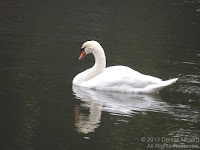MUTE SWAN
MUTE SWAN (Cygnus olor) – (See images below)
The Mute swan is native to Europe and much of Asia, and was introduced elsewhere in the world such as North America. With an average weight of 25 lb the male mute swan is among the heaviest flying birds. It is about 5 feet long and the adults are completely white. They have an orange bill with a black knob at the base. As with other swans it flies with its neck in the straight position, as opposed to herons and egrets.
This swan is protected in most introduced areas, and is kept in park ponds and other public water areas thanks to its beauty and graceful movements. One of the mute swan postures has been immortalized as a sign of love : when a couple is facing each other and are close, their silhouette forms a heart shape. A less pretty picture of those attractive public park birds is the fact that some have escaped into adjacent areas and have become naturalized, to the point where in some places they are now treated as an invasive species due to the damage they inflict to crops or water plants, since these constitute their diet.
But in Japan, there are still few of them, mainly in park ponds, while the wild ones migrate from other Asian countries to Japan mainly in the winter. The mute swan has been celebrated in Japanese poetry since more than 1,000 years. This is also the bird that Hans Christian Andersen chose for his tale ‘The Ugly Duckling’, as the mute swan juvenile looks very different from the adult, with grey down and no white.
The Mute swan is native to Europe and much of Asia, and was introduced elsewhere in the world such as North America. With an average weight of 25 lb the male mute swan is among the heaviest flying birds. It is about 5 feet long and the adults are completely white. They have an orange bill with a black knob at the base. As with other swans it flies with its neck in the straight position, as opposed to herons and egrets.
This swan is protected in most introduced areas, and is kept in park ponds and other public water areas thanks to its beauty and graceful movements. One of the mute swan postures has been immortalized as a sign of love : when a couple is facing each other and are close, their silhouette forms a heart shape. A less pretty picture of those attractive public park birds is the fact that some have escaped into adjacent areas and have become naturalized, to the point where in some places they are now treated as an invasive species due to the damage they inflict to crops or water plants, since these constitute their diet.
But in Japan, there are still few of them, mainly in park ponds, while the wild ones migrate from other Asian countries to Japan mainly in the winter. The mute swan has been celebrated in Japanese poetry since more than 1,000 years. This is also the bird that Hans Christian Andersen chose for his tale ‘The Ugly Duckling’, as the mute swan juvenile looks very different from the adult, with grey down and no white.
 |
| Mute swan, Imperial Palace Gardens, Tokyo |
 |
| Mute swan self-preening, Tokyo |